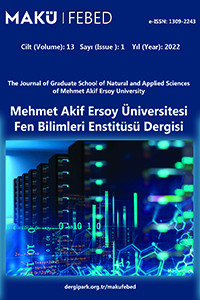Arduino-Tabanlı Elektrometre Tasarımı ve Metal Oksit Yarıiletken Uygulamaları
Arduino-UNO, elektrometre, logaritmik yükselteç, metal oksit
Arduino-Based Electrometer Design and Metal Oxide Semiconductor Applications
Arduino-UNO, electrometer, logarithmic amplifier, metal oxide,
___
- Abu EL-Fadl, A., Galal, A.M., Abd El-Moiz, A.B., Rashad, M. (2005). Optical constants of Zn1−xLixO films prepared by chemical bath deposition technique. Physica B Condensed Matter, 366(1-4): 44-54.
- Acharya, Y.B. , Vyavahare, P.D. (2000). A low current logarithmic LED electrometer. IEEE Transactions on Instrumentation and Measurement, 49: 5-9.
- Acharya, Y.B. (2006). Logarithmic current electrometer using commercially available current conveyor AD844. International Journal of Electronics, 4(93): 223-229.
- Atay, F. (2001). Cd1-xNixS filmlerinin elektriksel, optiksel, yapısal ve yüzeysel özelliklerinin incelenmesi. Doktora Tezi, Eskişehir Osmangazi Üniversitesi, Eskişehir.
- Bilgin, V. (2003). ZnO filmlerinin bazı elektrik, optik, yapısal ve yüzeysel özellikleri üzerine kalay katkısının etkisi. Doktora Tezi, Eskişehir Osmangazi Üniversitesi, Eskişehir.
- Birgin, E.G., Chambouleyron, I., Martinez, J.M. (1999). Estimation of optical constants of thin films using unconstrain optimization. Journal of Computational Physics, 151: 862-888.
- Bougrine, A., El Hichou, A., Addou, M., Ebothé, J., Kacho-uane, A., Troyon, M. (2003). Structural, optical and cathodoluminescence characteristics of undoped and tindoped ZnO thin films prepared by spray pyrolysis. Materials Chemistry and Physics, 80(2): 438-445.
- Chopra, K.L., Major, S., Pandya, K. (1983). Transparent conductors: A status review. Thin Solid Films, 102(1), 1-46.
- Chui, C.O., Ito, F., Saraswat, K.C. (2006). Nanoscale germanium MOS dielectrics: Part I. Germanium oxynitrides. IEEE Transactions. Electron. Devices, 53(7); 1501–1508.
- Du, Y., Zhang, M.S., Hong, J., Shen, Y., Chen, Q., Yin, Z. (2003). Structural and optical properties of nanophase zinc oxide. Applied Physics A, 76: 171-176.
- Evangelou, E.K., Mavrou, G., Dimoulas, A., Konofaos, N. (2007). Rare earth oxides as high-k dielectrics for Ge based MOS devices: An electrical study of Pt/Gd2O3/Ge capacitors. Solid-State Electronics, 51(1): 164-169.
- Fay, S., Kroll, U., Bucher, C., Vallat-Sauvain, E., Shah, A. (2005). Low pressure chemical vapour deposition of ZnO layers for thin-film solar cells: Temperature-induced morphological changes. Solar Energy Materials and Solar Cells, 86(3): 385-387.
- Khairurrijal, M.A., Suhendi, A., Munir, M.M., Surachman, A. (2007). A simple microcontroller-based current elect-rometer made from LOG112 and C8051F006 for measuring current in metal-oxide-semiconductor devices. Measurement Science and Technology, 18: 3019-3024.
- Khairurrijal, W.M., Miyazaki, S., Hirose, M. (2000a). Analy-tic model of direct tunnel current through ultrathin gate oxides. Journal of Applied Physics, 87(6): 3000-3005.
- Khairurrijal, W.M., Miyazaki, S., Hirose, M. (2000b). Unified analytic model of direct and Fowler-Nordheim tunnel currents through ultrathin gate oxides. Applied Physics Letters, 77(23): 3580-3582.
- Rajput, S.S., Jamuar, S.S. (2002). Low voltage, low power, highperformance type II current conveyor-based linear current electrometer. Review of Scientific Instruments, 73(10): 3644–3651.
- Rajput, S.S. (2003). An improved multigain range linear current electrometer. Review of Scientific Instruments, 74(6): 3120-3126.
- URL-1 (2023) https://www.ti.com/lit/ds/symlink/log2112.pdf (Erişim Tarihi: 22.02.2023)
- URL-2 (2023) https://www.ti.com/product/LOG114 (Erişim Tarihi: 22.02.2023)
- Vigil, O., Vaillant, L., Cruz, F., Santana, G., Morales-Acevedo, A., Contreras-Puente, G. (2000). Spray pyrolysis deposition of cadmium–zinc oxide thin films. Thin Solid Films, 361: 53-55.
- Wang, C., Zhao, J.C., Wang, X.M., Mai, B.X., Sheng, G.Y., Peng, P.A., Fu. J.M. (2002). Preparation, characterization and photocatalytic activity of nano-sized ZnO/SnO2 coupled photocatalysts. Applied Catalysis B: Environmental, 39(3): 269-279.
- Yıldırım, T., Gür, Emre., Tüzemen, S., Bilgin, V., Köse, S., Atay, F., Akyüz, I. (2005). Wide-bandgap modification of polycrystalline ZnO using Sn component on the basis of developing quantum-well hetero-structure. Physica E: Low-dimensional Systems and Nanostructures, 27(1): 290-295.
- Yıldırımlar, A. (2014). Zn tabanlı heteroeklemlerin kapasi-tans-voltaj karakterizasyonu. Yüksek Lisans Tezi, Burdur Mehmet Akif Ersoy Üniversitesi, Fen Bilimleri Enstitüsü, Fizik Anabilim Dalı, Burdur.
- Zahedi, F., Dariani, R.S., Rozati, S.M. (2014). Structural, optical and electrical properties of ZnO thin films prepared by Spray Pyrolysis: Effect of precursor concentration. Bulletin of Materials Science, 37: 433–439.
- Yayın Aralığı: Yılda 2 Sayı
- Başlangıç: 2010
- Yayıncı: Burdur Mehmet Akif Ersoy Üniversitesi
Turistik Mekân Göstergeleri ve Mimarlık: Pamukkale ve Karahayıt Üzerinden Bir İnceleme
Gözde KAN ÜLKÜ, Işıl UÇMAN ALTINIŞIK
Isparta’da Doğal Olarak Yetişen Tıbbi ve Aromatik Bitkilerle Oluşturulan Bir Şifa Bahçesi Örneği
Beste KARA, Şirin DÖNMEZ, Emine ŞİMŞEK
Botanik Parkların Rekreasyonel İşlevlerinin Kullanıcı Katılımı ile Değerlendirilmesi
Nilüfer SEYİDOĞLU AKDENİZ, Şerife Doğanay YENER
Çanakkale Merkez İlçedeki Bazı Parkların Kent Mobilyaları Açısından Değerlendirilmesi
Rastgele Sayı Üretimi İçin Tesla Küresi Kullanılabilir mi?
Horasan Harcında Şeker Pancarı Posasının Lif Katkı Olarak Kullanılabilirliğinin Araştırılması
Aslı ÇÜÇEN, Yusuf Tahir ALTUNCI
Hastane İç Mekânlarında Yaşlılar için Renk Kullanımı
Makbule Berfin BÜKER, Zuhal KAYNAKCI ELİNÇ
Selçuk FİLİZ, Ali Kemal BİRGÜCÜ, Alime BAYINDIR EROL
CBS Tabanlı Kentsel Gürültü Kirliliği Analizi ve Haritalandırılması: Antalya Örneği
Kentsel Koruma Politikalarının Uygulama Bağlamında Değerlendirilmesi: Uşak Kentsel Sit Alanı Örneği
